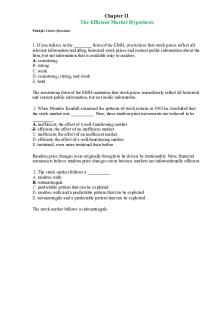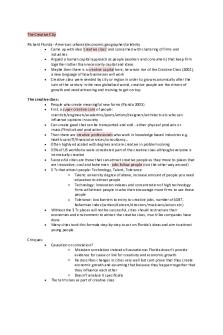Lecture 6 Notes - The Efficient Market Hypothesis PDF

| Title | Lecture 6 Notes - The Efficient Market Hypothesis |
|---|---|
| Author | Davis Pham |
| Course | Investment and Portfolio Analysis |
| Institution | Auckland University of Technology |
| Pages | 11 |
| File Size | 560.8 KB |
| File Type | |
| Total Downloads | 18 |
| Total Views | 147 |
Summary
These notes are simplified and complied from the textbook and the lecture in my own words - I did not miss any content, and I have been getting high grades for the quizzes. These notes will help you for the final exam revision. The tutor and lecturer is Peming...
Description
Lecture 6: The Efficient Market Hypothesis – Chapter 8
Random Walks and the Efficient Market Hypothesis (EMH) Efficient Market Hypothesis (EMH) -
The hypothesis that price of securities fully reflect available information about securities
Random Walk -
The notion that stock price changes are random and unpredictable
Why should stock prices follow a random walk when market is efficient? 1. In very competitive markets prices increases or decrease only when new information arrives 2. Arrival of new information, by definition, is unpredictable and random 3. Therefore, price changes must be unpredictable and random
How stock prices react to new information in an efficient market: Example one
How stock prices react to new information in an efficient market: Example two
Forms of the EMH (Efficient Market Hypothesis) -
Security prices reflect all relevant information
Weak Form EMH -
Asserts that stock prices already reflect all information that can be derived by examining market trading data, such as the history of past prices, trading volume, or short interest
-
Technical analysis won’t work
-
The relevant information is historical prices and other trading data such as trading volume.
-
If the markets are weak form efficient, use of such information provides no benefit after cost of obtaining and using the information.
Semi-Strong Form EMH -
States that all publicly available information regarding the prospects (future) of a firm already must be reflected in the stock price
-
Information includes, past prices, fundamental data on the firm’s product line, quality of management, balance sheet composition, patents held, earning forecast, and accounting practices
-
The relevant information is "all publicly available information, including past price and volume data."
-
If the markets are semi-strong form efficient, then studying past price and volume data & studying earnings and growth forecasts provides no net benefit in predicting price changes at the margin.
Strong Form EMH -
States that stock prices reflect all information relevant to the firm, even including information available only to company insiders
-
Security prices reflect all public and private information (including inside information).
-
The relevant information is “all information” both public and private or “inside” information
-
If the markets are strong form efficient, use of any information (public or private) provides no benefit at the margin.
-
There are trading limits by corporate insiders, (officers, directors and major shareholders). Inside trading must be reported.
Summary: Three Forms of Market Efficiency
Relationships between forms of the EMH (Efficient Market Hypothesis) -
Common Thing about these hypothesis is that they all assert that price should reflect available information
Implications of the EMH (Efficient Market Hypothesis) Technical analysis (TA)
-
Essentially the search for recurrent and predictable patterns in stock price
-
Technical Analyst are sometimes called chartists, because they study records or charts of past stock prices, hoping to find patterns they can exploit to make a profit
-
Using historical prices and volume information to predict future price changes by examining recurring and predictable patterns in prices and exploiting them to make a profit. o
TA assumes prices follow predictable trends
o
If the markets are weak form efficient or semi-strong form efficient or strong form efficient will technical analysis be able to consistently predict price changes?
Two common components of technical analysis:
Resistance Level -
A price level above which it is supposedly unlikely for a stock or stock index to rise
-
Price levels above which it is difficult for stock prices to rise
Support level -
A price level below which it is supposedly unlikely for stock or stock index to fall
Fundamental analysis -
Uses earnings and dividend prospects of the firm, expectation of future interest rates, and risk evaluation of the firm to determine proper stock prices
-
It represents an attempt to determine the present discounted value of all payments a stockholder will receive from each share of stock (If that value exceeds the stock price, the fundamental analyst would recommend purchasing the stock
-
Fundamental Analysis is much more difficult than merely identifying wellrun firms with good prospects
-
Using economic and accounting information, such as earnings and dividend prospects of the firm, expectations of future interest rates, and risk evaluation of the firm, to predict stock price changes and determine proper stock prices.
If the markets are weak form efficient or semi-strong form efficient or strong form efficient will fundamental analysis be able to consistently predict price changes?
If the markets are only weak form efficient? -
Fundamental Analysis CAN predict price changes
If the markets are semi-strong or strong form efficient? -
Fundamental Analysis CANNOT predict price changes
Implications of the EMH Even if the market is efficient, a role exists for portfolio management. 1. A basic principle in portfolio selection is diversification. 2. Other factors such as tax bracket, age, risk aversion, and employment, etc. The role of portfolio management is to tailor the portfolio to these needs, rather than to beat the market.
Implications of Efficiency for Active or Passive Investment Management
Are Markets Efficient? Tests of Weak Form: Patterns in Stock Prices Returns over short horizons -
One way of discerning (having or showing good judgement) trends in stock prices is by measuring the serial correlation of stock market returns: serial correlation refers to the tendency for stock returns to be related to past returns
-
Studies find positive serial correlation over short horizons, though the correlation coefficients tend to be small.
-
For intermediate horizon (3-12 months), studies find a momentum effect: the tendency of poorly performing and well performing stocks in one period to continue that abnormal performance in following periods.
Positive Serial Correlation -
Means that positive returns tend to follow positive return (a momentum type of property)
Negative Serial Correlation -
Means that positive returns tend to be followed by negative returns (a reversal or “correction” property)
In an investigation of intermediate-horizon stock price behaviour (using 3 to 12 months holding period) – Jegedeesh and Titman (1993) found a momentum effect in which good or bad recent performance of particular stock continues over time
Momentum Effect -
The tendency of poorly performing stocks and well-performing stocks in one period to continue that abnormal performance in following period
Returns over long horizons -
The latter result has given rise to a “fads hypothesis” which asserts that the stock market might overreact to relevant news – Such overreaction leads to positive serial correlation (momentum) over short-time horizon
-
Subsequent correction of the overreaction leads to poor performance following good performance and vice versa – The correction means that a run of positive returns eventually will tend to be followed by negative returns, leading to negative serial correlation over longer horizon
-
Studies find negative serial correlation over long horizons.
Reversal Effect -
The tendency of poorly performing stocks and well-performing stocks in one period to experience reversals in the following period
-
This reversal effect, in which losers rebound and winners fade back, suggest that the stock market overreacts to relevant news – After the overreaction is recognized, extreme investment performance is reversed
-
The reversal effect suggests a contrarian investment strategy: investing in recent losers and avoiding recent winners.
Are Markets Efficient? Tests of Semi-strong Form: Market Anomalies Anomalies -
Patterns of returns that seem to contradict the efficient market hypothesis
-
Patterns of returns that seem to contradict the EMH are called market anomalies.
P/E Effect -
Portfolios of low P/E Stocks have exhibited higher average risk-adjusted returns than high P/E stocks
The Small-Firm Effect -
Stocks of small firms have earned abnormal returns, primarily in the month of January
-
Small Firm or Size Effect (January Effect) Stocks of small firms have earned abnormal returns, primarily in January.
The Size Effect from 1926 to 2003
Neglected Firm Effect -
The tendency of investment in stock of less well-known firms to generate abnormal returns
-
Neglected firms might be expected to earn higher equilibrium returns as compensation for risk associated with limited information
-
Investments in stocks of less-well-known firms tend to generate abnormal returns.
Book-to-market Ratios Effect
-
The tendency for investment in shares of firms with high ratios of book value to market value to generate abnormal returns
-
Shares of firms with high ratios tend to generate abnormal returns.
Post-Earnings Announcement Price Drift
The sluggish response to firms’ earnings announcements.
Are Markets Efficient? Tests of Strong Form: Inside Information -
The ability of insiders to trade profitably in their own stocks has been documented. This indicates that market is not strong-form efficient.
-
Do the above patterns and anomalies contradict EMH? Debate still goes on.
Summary: What Does the Evidence Show? Anomalies Exist
Small Firm in January Effect Book to Market Ratios Long Term Reversals Post-Earnings Announcement Drift (Momentum)...
Similar Free PDFs

Ch11 The Efficient Market Hypothesis
- 23 Pages

Efficient Market Hypothesis
- 5 Pages

Hypothesis - Lecture notes 2
- 3 Pages

Lecture notes, lecture 6
- 3 Pages

Lecture 8 Hypothesis Testing
- 57 Pages

Lecture 7 - Insurance hypothesis
- 2 Pages

The Hamitic Hypothesis
- 2 Pages
Popular Institutions
- Tinajero National High School - Annex
- Politeknik Caltex Riau
- Yokohama City University
- SGT University
- University of Al-Qadisiyah
- Divine Word College of Vigan
- Techniek College Rotterdam
- Universidade de Santiago
- Universiti Teknologi MARA Cawangan Johor Kampus Pasir Gudang
- Poltekkes Kemenkes Yogyakarta
- Baguio City National High School
- Colegio san marcos
- preparatoria uno
- Centro de Bachillerato Tecnológico Industrial y de Servicios No. 107
- Dalian Maritime University
- Quang Trung Secondary School
- Colegio Tecnológico en Informática
- Corporación Regional de Educación Superior
- Grupo CEDVA
- Dar Al Uloom University
- Centro de Estudios Preuniversitarios de la Universidad Nacional de Ingeniería
- 上智大学
- Aakash International School, Nuna Majara
- San Felipe Neri Catholic School
- Kang Chiao International School - New Taipei City
- Misamis Occidental National High School
- Institución Educativa Escuela Normal Juan Ladrilleros
- Kolehiyo ng Pantukan
- Batanes State College
- Instituto Continental
- Sekolah Menengah Kejuruan Kesehatan Kaltara (Tarakan)
- Colegio de La Inmaculada Concepcion - Cebu








